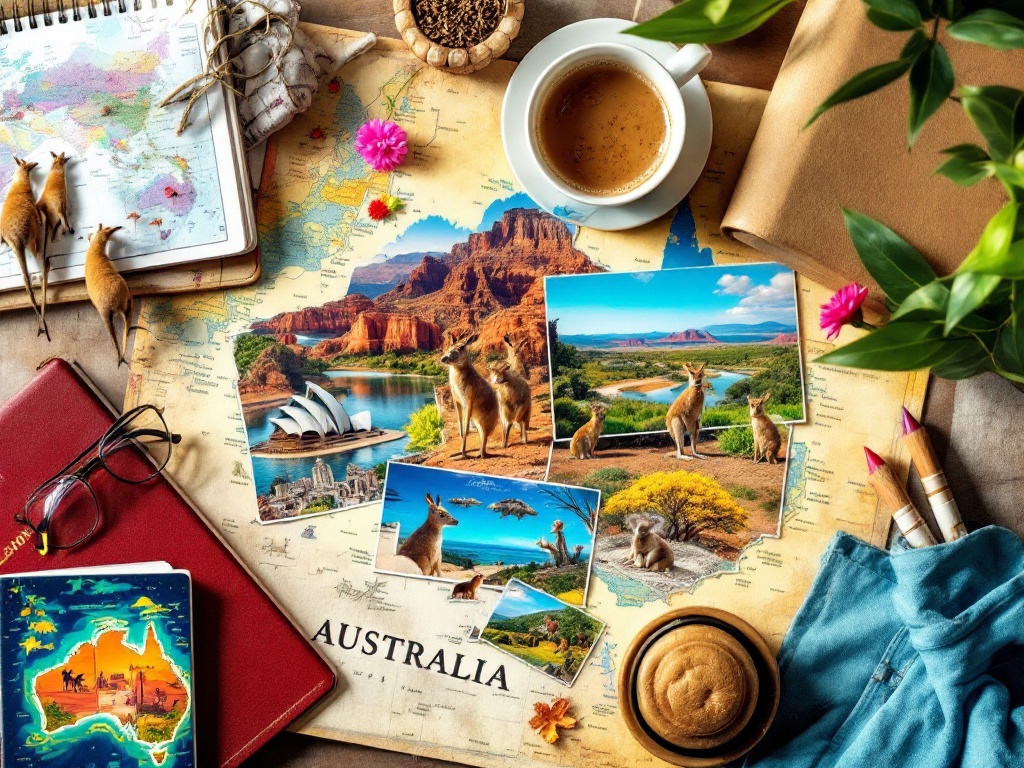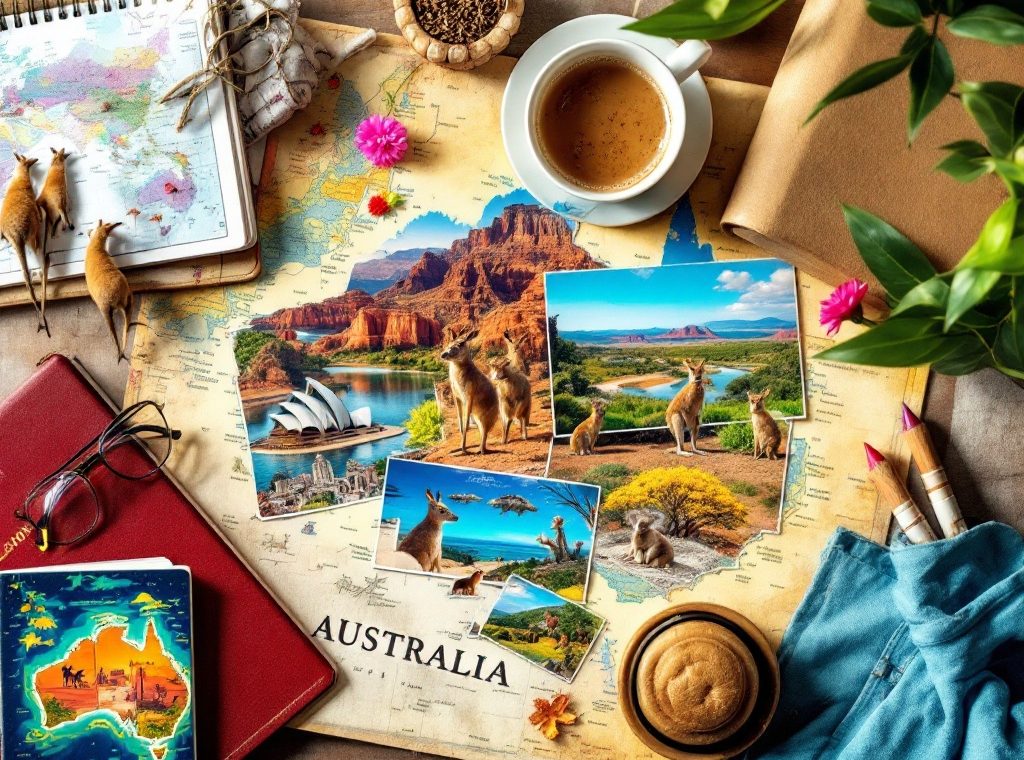Traveling to Australia: Important Preparations
Dreaming of Australia’s stunning landscapes and unique wildlife? Turn your dream into a reality with our comprehensive guide to planning your Australian adventure! From securing the right visa (a quick ETA for US citizens!) to budgeting for your trip and understanding essential health and safety precautions, we’ve got you covered. Discover how to navigate Australia’s diverse climates, transportation options, and even its vast distances. Start planning your unforgettable trip today!
Important information

- A valid passport and visa (or ETA for eligible nationalities like US citizens for visits up to 90 days) are required for entry.
- Australia has strict biosecurity laws; declare all food, plant, and animal products upon arrival.
- Travel insurance and comprehensive health preparations (consultations with a doctor, vaccinations) are recommended.
- Sun protection is vital due to Australia’s high UV index. Use high-SPF sunscreen, wear a hat, and seek shade.
- Distances between cities are vast. Consider domestic flights for long journeys and utilize public transport within urban areas.
Visa and Immigration Requirements for Traveling to Australia
Planning a trip to Australia? A valid passport is essential, along with a visa or an Electronic Travel Authority (ETA). US citizens traveling for tourism or business can obtain an ETA for visits up to 90 days—a quick and convenient process. Other nationalities, however, may require a traditional visa. Be sure to research the specific requirements based on your citizenship and the purpose of your visit to ensure a hassle-free Australian adventure.
What U.S. Passport Holders Need to Know About ETA
Traveling to Australia is now easier than ever for U.S. passport holders. With an Electronic Travel Authority (ETA), you can enjoy up to 90 days of tourism or business travel. This authorization is electronically linked to your passport, streamlining the entry process. Applying for an ETA is simple and can be done online, allowing you to focus on planning your Australian adventure.
Visa Requirements for Foreign Travelers
Your nationality plays a key role in determining your visa requirements for Australia. A valid passport is essential, and most nationalities require a visa or Electronic Travel Authority (ETA) before arrival. For specific details based on your citizenship, consult the Australian Department of Home Affairs website. You may also need health documents, such as proof of vaccination.
Visa Costs and Duration
A visitor visa, valid for three months, costs $145. This generous timeframe gives tourists ample opportunity to experience the country.
Understanding the Passenger Card and Biosecurity Declarations
Planning a trip to Australia? You’ll need to complete a digital Incoming Passenger Card. This card requires your personal details, travel information, and visa details. Accuracy is key, as incorrect information could lead to visa issues. Australia maintains strict biosecurity regulations. Be sure to declare all food, plant, and animal products. This includes wooden items and even outdoor gear like hiking boots. When in doubt, declare it to avoid potential fines.
Complete the digital Incoming Passenger Card.
Provide accurate personal, travel, and visa details.
Declare all food, plant, and animal products to comply with Australia’s biosecurity regulations.
Budgeting and Costs Associated with Traveling to Australia
Planning your Australian adventure requires careful budgeting. Australia can be an expensive destination, but smart planning can help you manage costs.
Managing Your Travel Costs
Consider these key aspects when planning your trip:
- Flights, carefully research and compare prices to find the best deals.
- Accommodation, explore various options, from budget-friendly hostels to comfortable hotels.
- Meals, local markets offer delicious and affordable options.
- Activities, Australia offers a wealth of free activities like hiking, exploring beaches, and visiting parks.
- Transportation, choose from public transport, ride-sharing, or car rentals depending on your budget.
Tips for Affordable Travel
Here are some effective ways to make your trip more affordable:
- Set a realistic budget and track your spending diligently.
- Seek out budget-friendly activities and free attractions.
- Consider hostels or budget hotels for accommodation.
- Prepare your own meals to save on dining expenses.
With careful planning, you can experience Australia without overspending.
Understanding the Expenses: Australia as a Travel Destination
Traveling to Australia doesn’t have to break the bank. With smart planning, you can tailor your trip to match your budget. Here’s a breakdown of how to make your Australian adventure affordable:
Accommodation
Australia offers a wide range of accommodation choices, from budget-friendly hostels for backpackers to luxurious hotels for a more comfortable stay. Consider camping or holiday rentals for other cost-effective options.
Food
Manage your food costs by exploring local markets, trying affordable takeaway options, or preparing your own meals. If you want to treat yourself, splurge on a fine dining experience now and then.
Transportation
Getting around Australia offers various choices. Domestic flights are convenient for long distances, while rental cars offer flexibility. Public transport, such as buses and trains, is a cost-effective option for shorter trips, especially in cities.
Activities
Explore Australia’s diverse landscape with free activities like walking tours, hiking, and visiting beaches and parks. For a more in-depth experience, consider guided tours or other paid attractions, balancing them with free options.
Visa and Insurance
Factor in visa fees and travel insurance costs when planning your trip. These are essential aspects of your travel budget.
Incidentals
Allocate a portion of your budget for incidentals like souvenirs, snacks, or unexpected expenses.
By creating a realistic budget that covers accommodation, food, transportation, visa fees, travel insurance, and incidentals, you can have an unforgettable Australian adventure without overspending.
Budget Planning Tips for Travelers
Planning your spending is key to an affordable Australian adventure. Consider these essential costs: lodging, flights, visas, and travel documents. Booking flights and accommodations in advance often secures better deals. Embrace Australia’s free activities: hiking scenic trails, exploring lush parks, and visiting captivating museums. Cooking your own meals can significantly cut down on dining expenses. Australia can be expensive, so a realistic budget is essential. Set a daily spending limit and track your expenses carefully. For transportation, consider budget-friendly choices like public transport or ride-sharing. Weekly public transport passes can be economical, but factor in travel time. Ride-sharing offers convenience, but prices can fluctuate.
Accommodation and Flights
Booking flights and accommodations in advance often results in better deals, saving you money on your trip.
Free Activities
Australia offers a wealth of free activities, including hiking scenic trails, exploring lush parks, and immersing yourself in captivating museums.
Food
Preparing some of your own meals can significantly reduce your dining expenses.
Budgeting
Set a daily spending limit and track your expenses diligently to manage your travel costs effectively.
Public Transport
Consider using public transport. Weekly passes can be economical, but remember to factor in travel time.
Ride-sharing
Ride-sharing offers convenience, but be aware that prices can vary.
Best Time to Visit and Weather Considerations
Australia’s diverse climate offers a range of travel experiences. For those seeking mild temperatures, southern cities like Sydney and Melbourne are delightful in the spring (September to November) and autumn (March to May). If you prefer tropical warmth, northern destinations like Cairns are ideal during the dry season (May to October). Checking regional forecasts before your trip will ensure a comfortable experience.
Understanding Australia’s Diverse Climates
Australia’s diverse climate varies significantly across regions. The northern part experiences a tropical climate with distinct wet and dry seasons. Southern Australia enjoys a temperate climate with four distinct seasons: spring, summer, autumn, and winter. Central Australia features an arid to semi-arid environment, marked by hot summers and mild winters. Coastal areas offer moderate temperatures, while inland regions experience greater temperature extremes. Research your specific destination’s climate to pack accordingly. For tropical northern areas, pack light clothing. For a winter trip to the south, pack warm layers. Consider your planned activities to further refine your packing list.
Weather Considerations for Trip Planning
Australia’s diverse climate varies from the tropical north, with its distinct wet and dry seasons, to the cooler, temperate south. Research your specific destination’s climate before your trip to pack accordingly.
Suggested Clothing
- Light clothing is ideal for summer.
- Warm layers are essential for winter.
- Rain gear is recommended year-round due to unpredictable weather changes.
Essential Item
Sun protection is crucial regardless of the season due to Australia’s high UV index.
Transportation and Road Safety
Traveling within Australia offers diverse options. For navigating major cities like Sydney, Melbourne, and Perth, public transport is highly recommended. Buses, trains, and trams provide efficient and convenient urban travel. To explore the expansive Australian countryside, a road trip is an excellent choice. Remember that Australians drive on the left-hand side of the road. An International Driving Permit is required if your driver’s license isn’t in English.
Distances between major cities
Due to Australia’s vast size, distances between cities are significant. Plan your trips carefully, considering realistic travel times. For longer journeys, domestic flights are a time-saving option.
- Sydney to Melbourne: approximately 878 km.
- Sydney to Perth: approximately 3,933 km.
Tips for travel in Australia
- Utilize public transport for efficient travel within major cities.
- Embark on a road trip to experience the Australian countryside.
- Remember to drive on the left-hand side of the road.
- Obtain an International Driving Permit if your license isn’t in English.
- Plan your trips carefully, considering the vast distances.
- Consider domestic flights for longer journeys.
Navigating Public Transport and Road Trips
Australia offers a comprehensive public transport network, including buses, trains, and ferries, ideal for exploring cities. However, to truly experience Australia, consider a road trip. The country’s landscapes range from arid deserts to lush rainforests. Remember that Australians drive on the left side of the road. Due to the often significant distances between locations, careful route planning is essential. Navigation apps are highly recommended, and a local SIM card or portable Wi-Fi device will help you stay connected.
Public Transport
Australia has a robust public transportation system, perfect for exploring cities and hopping between urban centers. Options include:
- buses,
- trains,
- ferries.
Road Trips
For the ultimate Australian adventure, embark on a road trip. Experience diverse landscapes, from deserts to rainforests. Important considerations:
- Australians drive on the left.
- Distances between destinations can be vast, so plan your route carefully.
- A navigation app and local SIM card or portable Wi-Fi are essential.
Understanding Distances in Australia
Planning a trip across Australia requires careful consideration of the country’s vast distances. For example, the journey between Sydney and Perth spans approximately 3,933 km. While a flight takes roughly 4 hours and 15 minutes, driving can consume around 40 hours. Similarly, the 1,677 km between Melbourne and Brisbane translates to a flight of about 1 hour and 45 minutes, while driving takes approximately 17 hours. Factor these travel times into your itinerary. Within cities, readily available public transport simplifies travel, especially with a helpful navigation and scheduling app. Remember that Australians drive on the left side of the road.
Health and Safety Precautions
Stay safe and healthy during your Australian adventure by following these tips:
Medical Care and Insurance: while Australia offers excellent medical care, travel insurance is recommended for all visitors.
Sun Protection: Australia’s sun is strong. Protect yourself with high-SPF sunscreen (30 or higher), a hat, and sunglasses, especially during peak sun hours. Seek shade whenever possible.
Wildlife Safety: Australia has amazing wildlife, but some animals can be dangerous. Exercise caution around venomous snakes, spiders, and jellyfish. Learn about local safety guidelines.
City Safety: Be aware of your surroundings, especially at night. Report any criminal activity to the police.
Health Preparations: Consult your doctor about recommended vaccinations and medications before your trip. Pack a well-stocked first-aid kit.
Beach Safety: Swim at patrolled beaches and be aware of strong currents and rips. Follow warning signs and flags.
Health Tips for Travelers
Consult your doctor before your trip to discuss necessary vaccinations and medications.
Pack a well-stocked first-aid kit with bandages, antiseptic wipes, and pain relievers.
Secure comprehensive travel insurance that covers medical emergencies and evacuations.
Stay hydrated by drinking plenty of water, especially in warmer climates.
Prioritize food safety by choosing reputable restaurants.
Travelers with pre-existing medical conditions should carry their medical records and inform their travel companions.
Locate nearby medical facilities at your destination.
Research potential health risks specific to your destination and take necessary precautions, such as using insect repellent.
Stay informed about local health advisories and guidelines.
The Importance of Sun Protection
Sun safety is crucial in Australia, which has the world’s highest skin cancer rates. Follow these steps to protect yourself from the sun’s harmful rays:
Use a high-SPF sunscreen and reapply frequently, especially after swimming or sweating.
Wear protective clothing, including a hat, sunglasses, and long sleeves.
Seek shade, particularly between 10 am and 4 pm when the sun’s rays are strongest.
Remember that skin damage can still occur on overcast days. Don’t be fooled by clouds.
Swimming Safety: Precautions to Take
Swim between the red and yellow flags, where lifeguards are on patrol for your safety.
Before entering the water, assess the beach conditions and be aware of potentially dangerous rips and currents.
Swimming with a friend or group is always recommended for enhanced safety.
Crime Awareness and Reporting in Australia
Report any criminal activity to your local police by dialing 000. Common offenses include:
- robberies,
- burglaries,
- assaults,
- car thefts.
These crimes are often concentrated in major urban centers.
Crime isn’t limited to cities; property crime affects smaller towns as well. Furthermore, cybercrime poses a growing national threat.
Remain alert and report any suspicious behavior.
















